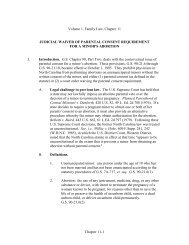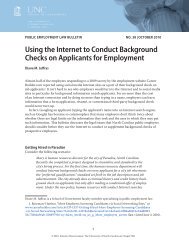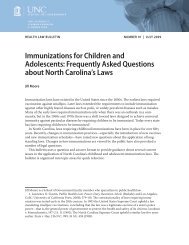Sentencing, Corrections, Prisons, and Jails - School of Government ...
Sentencing, Corrections, Prisons, and Jails - School of Government ...
Sentencing, Corrections, Prisons, and Jails - School of Government ...
Create successful ePaper yourself
Turn your PDF publications into a flip-book with our unique Google optimized e-Paper software.
<strong>Sentencing</strong>, <strong>Corrections</strong>, <strong>Prisons</strong>, <strong>and</strong> <strong>Jails</strong> 233<br />
defined by the SSA. G.S. 15A-1340.11(8). Although IMPACT will no longer be a part <strong>of</strong> special<br />
probation, it will continue to be a condition <strong>of</strong> probation <strong>and</strong> will continue to qualify, under G.S. 15A-<br />
1340.11(6)b, as an intermediate punishment for purposes <strong>of</strong> the SSA. The eligibility criteria for<br />
IMPACT remain unchanged: The <strong>of</strong>fender must be sixteen to thirty years <strong>of</strong> age; must be convicted <strong>of</strong><br />
a felony or a Class 1 or A1 misdemeanor; <strong>and</strong> must pass a medical examination.<br />
Now that IMPACT has become a residential treatment program rather than special probation, it is<br />
unclear whether time spent in it will continue to count toward an activated term <strong>of</strong> imprisonment if an<br />
<strong>of</strong>fender’s probation is revoked. The N.C. Supreme Court held, in State v. Farris, 336 N.C. 552, 444<br />
S.E.2d 182 (1993), that time spent in confinement as a condition <strong>of</strong> special probation must be credited<br />
toward the activated term.<br />
Section 17.1 <strong>of</strong> S.L. 1998-212 (S 1366) requires DOC to evaluate IMPACT as well as the Post-<br />
Boot Camp Program <strong>and</strong> report annually by March 1 to the Joint Legislative Commission on<br />
<strong>Government</strong>al Operations, the Joint Legislative <strong>Corrections</strong> <strong>and</strong> Crime Control Oversight Committee,<br />
<strong>and</strong> the Fiscal Research Division. The evaluation must include any available information on the<br />
difference in outcome among <strong>of</strong>fenders who attend IMPACT only; those who attend IMPACT <strong>and</strong><br />
receive Post-Boot Camp aftercare; <strong>and</strong> similar <strong>of</strong>fenders who receive other intermediate sanctions.<br />
It is worth noting that in the most recent recidivism study by the <strong>Sentencing</strong> Commission, 46.4<br />
percent <strong>of</strong> 740 persons placed in IMPACT during 1994–95 were rearrested for an alleged new crime<br />
during a follow-up period averaging thirty-five months, compared to 38.5 percent for all 1,916 persons<br />
sentenced to special probation <strong>and</strong> 31.3 percent for 27,241 persons sentenced to regular probation. Two<br />
possible explanations <strong>of</strong> the higher recidivism rate are that (1) IMPACT participants are younger<br />
(average age <strong>of</strong> nineteen) than other special probationers <strong>and</strong> regular probationers (average age <strong>of</strong><br />
twenty-nine), <strong>and</strong> criminal activity tends to peak in the late teens; <strong>and</strong> (2) they are selected for<br />
IMPACT precisely because they have a higher degree <strong>of</strong> crime involvement than other probationers.<br />
(The commission’s most recent recidivism study indicated that about 46 percent <strong>of</strong> IMPACT<br />
participants could be classified as high risk, in terms <strong>of</strong> criminal history, current <strong>of</strong>fense, age, <strong>and</strong> other<br />
factors that predict recidivism, while only about 31 percent <strong>of</strong> regular probationers in the study were<br />
classified as high risk.)<br />
Post-Release Supervision <strong>and</strong> Parole Commission<br />
S.L. 1998-212 (S 1366), Section 17.13, requires the Post-Release Supervision <strong>and</strong> Parole<br />
Commission to report by March 1, 1999, to the chairs <strong>of</strong> the Senate <strong>and</strong> House Appropriations<br />
Subcommittees on Justice <strong>and</strong> Public Safety <strong>and</strong>, upon request, to the chairs <strong>of</strong> the Joint Legislative<br />
<strong>Corrections</strong> <strong>and</strong> Crime Control Oversight Committee after March 1, 1999. The report must cover the<br />
commission’s progress in reviewing cases under Robbins v. Freeman, 127 N.C. App. 162, 487 S.E.2d<br />
771 (1997), in which the N.C. Court <strong>of</strong> Appeals held invalid the practice <strong>of</strong> “paper parole.” “Paper<br />
parole” was a practice involving certain prisoners with multiple consecutive prison sentences in which<br />
the commission would “parole” the prisoner from one sentence without actually releasing him from<br />
prison to begin serving his next sentence. The court <strong>of</strong> appeals, whose decision was affirmed by the<br />
supreme court, held that the commission must follow G.S. 15A-1354(b), which requires that multiple<br />
consecutive sentences be added together <strong>and</strong> treated as a single sentence for purposes <strong>of</strong> parole. This<br />
decision means that the commission has had to recompute the time that some prisoners must serve<br />
before becoming eligible for parole.<br />
The report required by Section 17.13 <strong>of</strong> the 1998 Appropriations Act also must contain an updated<br />
plan for reducing the commission’s staff through the 2002–03 fiscal year, including a 10 percent<br />
reduction in staff positions in 1999–2000 compared to 1998–99. The staff reduction is thought<br />
appropriate because the SSA abolished parole in 1994 <strong>and</strong> the number <strong>of</strong> prisoners still eligible for<br />
parole under former law has been dwindling. This decline in parole workload will be <strong>of</strong>fset to some<br />
extent by the growing number <strong>of</strong> prisoners eligible for supervised release under the SSA. It will be<br />
<strong>of</strong>fset as well by the increase in the prison population during the last few years. Because <strong>of</strong> the rapid<br />
increase in prison capacity that occurred as a result <strong>of</strong> the legislation accompanying structured<br />
sentencing, the average daily prison population has grown, from an average <strong>of</strong> 20,986 in 1993, the last<br />
full year before the SSA took effect, to 32,060 in 1997.













